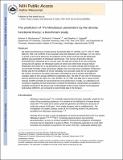Prediction of [superscript 57] Fe Mossbauer Parameters by Density Functional Theory: A Benchmark Study
Author(s)
Bochevarov, Arteum D.; Friesner, Richard A.; Lippard, Stephen J.
DownloadLippard_The prediction.pdf (888.1Kb)
PUBLISHER_POLICY
Publisher Policy
Article is made available in accordance with the publisher's policy and may be subject to US copyright law. Please refer to the publisher's site for terms of use.
Terms of use
Metadata
Show full item recordAbstract
We report the performance of eight density functionals (B3LYP, BPW91, OLYP, O3LYP, M06, M06-2X, PBE, and SVWN5) in two Gaussian basis sets (Wachters and Partridge-1 on iron atoms; cc-pVDZ on the rest of atoms) for prediction of the isomer shift (IS) and quadrupole splitting (QS) parameters of Mössbauer spectroscopy. Two sources of geometry (density functional theory optimized and X-ray) are used. Our data set consists of 31 iron-containing compounds (35 signals), the Mössbauer spectra of which were determined at liquid helium temperature and where the X-ray geometries are known. Our results indicate that the larger and uncontracted Partridge-1 basis set produces slightly more accurate linear correlations of electronic density used for prediction of IS and noticeably more accurate results for the QS parameters. We confirm and discuss the earlier observation of Noodleman and co-workers that different oxidation states of iron produce different IS calibration lines. The B3LYP and O3LYP functionals have the lowest errors for either IS or QS. BPW91, OLYP, PBE, and M06 have mixed success, whereas SVWN5 and M06-2X demonstrate the worst performance. Finally, our calibrations and conclusions regarding the best functional to compute the Mössbauer characteristics are applied to candidate structures for the peroxo and Q intermediates of the enzyme methane monooxygenase hydroxylase (MMOH) and are compared to experimental data in the literature.
Date issued
2010-11Department
Massachusetts Institute of Technology. Department of ChemistryJournal
Journal of Chemical Theory and Computation
Publisher
American Chemical Society (ACS)
Citation
Bochevarov, Arteum D., Richard A. Friesner, and Stephen J. Lippard. “Prediction of 57 Fe Mössbauer Parameters by Density Functional Theory: A Benchmark Study.” Journal of Chemical Theory and Computation 6.12 (2010): 3735–3749.
Version: Author's final manuscript
ISSN
1549-9618
1549-9626